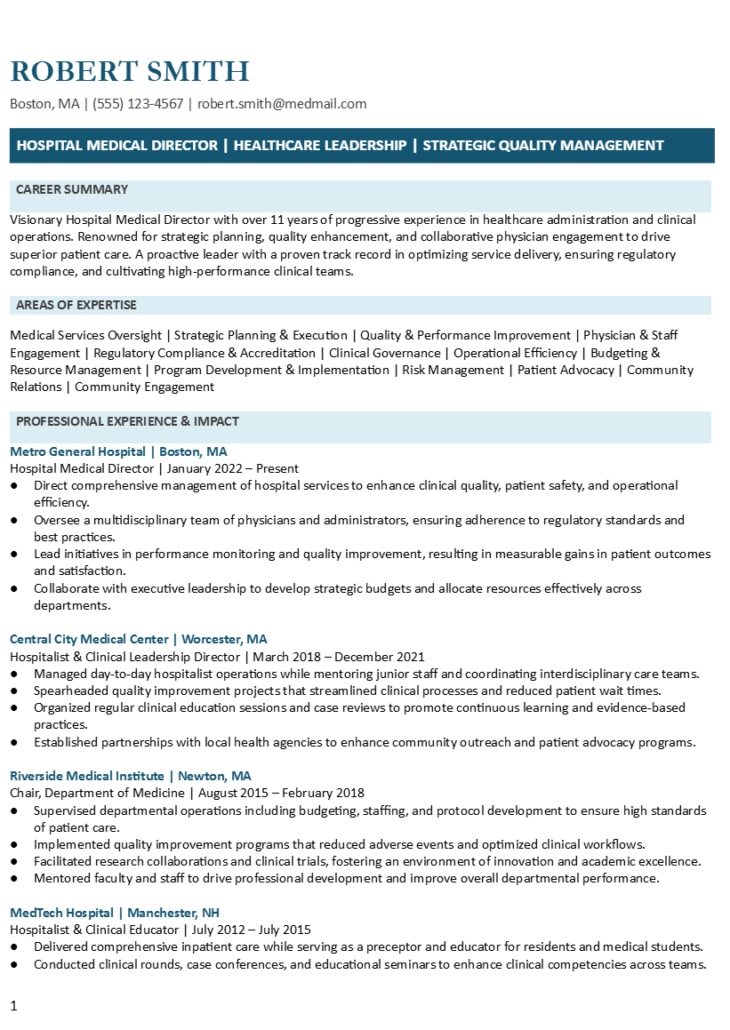Hospital Medical Director Resume Example

About this resume
IndustryCarrer Level Executive
Written by Resume Writing Lab
Order Similar Download Sample

ROBERT SMITH
Boston, MA | (555) 123-4567 | [email protected]
| HOSPITAL MEDICAL DIRECTOR | HEALTHCARE LEADERSHIP | STRATEGIC QUALITY MANAGEMENT |
CAREER SUMMARY
Visionary Hospital Medical Director with over 11 years of progressive experience in healthcare administration and clinical operations. Renowned for strategic planning, quality enhancement, and collaborative physician engagement to drive superior patient care. A proactive leader with a proven track record in optimizing service delivery, ensuring regulatory compliance, and cultivating high-performance clinical teams.
AREAS OF EXPERTISE
Medical Services Oversight | Strategic Planning & Execution | Quality & Performance Improvement | Physician & Staff Engagement | Regulatory Compliance & Accreditation | Clinical Governance | Operational Efficiency | Budgeting & Resource Management | Program Development & Implementation | Risk Management | Patient Advocacy | Community Relations | Community Engagement
PROFESSIONAL EXPERIENCE & IMPACT
Metro General Hospital | Boston, MA
Hospital Medical Director | January 2022 – Present
Central City Medical Center | Worcester, MA
Hospitalist & Clinical Leadership Director | March 2018 – December 2021
Riverside Medical Institute | Newton, MA
Chair, Department of Medicine | August 2015 – February 2018
MedTech Hospital | Manchester, NH
Hospitalist & Clinical Educator | July 2012 – July 2015
VOLUNTEER EXPERIENCE
City Health Outreach Program | Boston, MA
Volunteer Medical Advisor | February 2011 – June 2012
RESEARCH EXPERIENCE
Harvard Medical School, Department of Infectious Diseases | Boston, MA
Research Assistant | May 2011 – August 2011
PROFESSIONAL TRAINING
Massachusetts General Hospital | Boston, MA
Internal Medicine Residency (ACGME Accredited) | July 2008 – June 2012
EDUCATION
Master of Business Administration (MBA) | Boston University, Questrom School of Business | 2015
Bachelor of Science in Biology | University of Massachusetts, Amherst | 2008
MEMBERSHIP AND HONORARY/PROFESSIONAL SOCIETIES
CERTIFICATIONS/LICENSURES
AWARDS
Recipient, Excellence in Clinical Leadership Award | 2022
Recipient, Excellence in Clinical Leadership Award |2018
Recognized by the Regional Healthcare Board for Outstanding Service | 2016
Below is a quick guide to crafting a polished executive resume for high-level healthcare leadership roles:
Header: Use a clean header with your full name, credentials (e.g., MBA, MD), location, phone number, professional email, and LinkedIn URL.
Brand Statement: Consider adding a concise tagline that summarizes your expertise (e.g., “HOSPITAL MEDICAL DIRECTOR | QUALITY IMPROVEMENT”).
Concise Overview: Write 3–4 sentences that capture your years of experience, leadership style, and core achievements.
Key Focus: Emphasize strategic planning, quality improvement, operational efficiency, and team building.
Tailor to Role: Ensure the summary speaks directly to the responsibilities and challenges of an executive leadership position in healthcare.
Bullet List: Include 10–15 bullet points of hard and soft skills that are directly relevant to the role (e.g., Regulatory Compliance, Program Development, Physician Engagement, Resource Management).
Keywords: Use industry-specific terminology that aligns with the job description and current trends in healthcare administration.
Reverse Chronological Order: Start with your most recent position and work backwards.
Clear Job Titles & Locations: Include the organization name, location, and your job title followed by employment dates.
Impact Statements: For each role, list bullet points that:
Highlight measurable achievements (e.g., improved patient outcomes, budget reductions, efficiency gains).
Use active language to describe leadership initiatives (e.g., “spearheaded,” “implemented,” “optimized”).
Emphasize collaboration, quality, and operational improvements.
Subsections for Roles: If you held multiple roles within the same organization, clearly segment each with dates and responsibilities.
Volunteering or Early Roles: Include non-executive roles that build your story if they add unique value (e.g., volunteer medical advisory positions or early research work).
Credentials: List degrees in reverse chronological order (MBA, MD, etc.) along with institution names, locations, and graduation dates.
Certifications: Clearly state relevant certifications (ACLS, PALS, Board Certifications) and include license numbers or expiry dates if applicable.
Continuous Learning: Highlight any executive training programs, residencies, or specialized fellowships that strengthen your expertise.
Professional Organizations: List memberships in respected bodies (e.g., AHA, ACHE).
Awards & Honors: Note any recognitions that underscore leadership, innovation, or clinical excellence.
Optional Sections: Consider adding sections for publications, research, or presentations if they reinforce your executive profile.
Clarity & Consistency: Use a consistent font, clear section headings, and a professional layout.
Conciseness: Prioritize impactful, quantifiable details. Executive resumes should be succinct yet rich in accomplishments.
Tailoring: Customize your resume for each role, ensuring that each section aligns with the job’s specific requirements.
Proofread: Ensure there are no errors. Accuracy is crucial in high-level roles.
Feedback: Consider having a peer or mentor in the industry review your resume for clarity and impact.
Digital Readiness: Optimize for both applicant tracking systems (ATS) and human readers by balancing keywords with compelling narrative.
Following these guidelines will help you build an executive resume that clearly communicates your leadership, operational excellence, and strategic impact in healthcare.